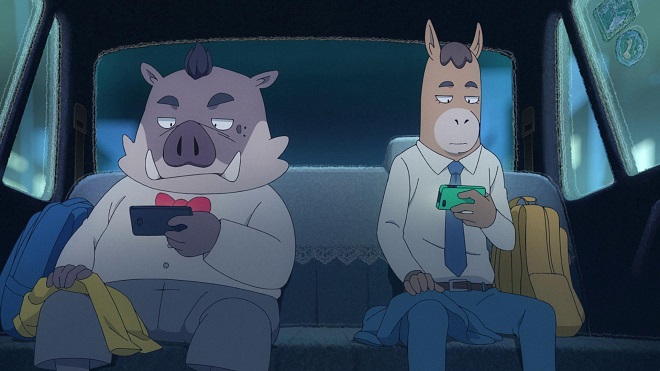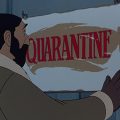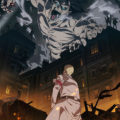Quarantine Control #56: A Cap in an Odd Castle

The ledes for prior Quarantine Control posts have been focused on North America because all of our writers are located within the continent. But other countries shouldn’t be ignored, particularly at this stage in the pandemic. The United States and the United Kingdom are recovering from COVID-19 thanks to vaccinations spreading around, but India is being thoroughly ravaged by it with cases and deaths racking up; Brazil isn’t faring that much better. It’s always a good time to remember that the pandemic isn’t over, and that more spreadable variants are rolling around. Cross your fingers and hope those variants don’t get too strong over time.
Geoffrey Barnes
The Falcon and the Winter Soldier (2021)
Source: Disney Plus
Episodes: 6 (the entire series)

The intention of The Falcon and the Winter Soldier was made clear early within the first episode, especially for anyone familiar with Marvel’s comics. With Steve Rogers out of the picture following Avengers: Endgame (which you hopefully knew about by now) someone else needed to take the mantle of Captain America. The series just finished nearly a week ago, so it’s tough to find anyone who doesn’t know how this series tells the story of Sam Wilson (Anthony Mackie) and his journey from the Falcon to Captain America. This was despite the red herrings the series threw at the viewer early on and midway through. The quest was an entertaining one, but the storytelling stumbles made the series less entertaining than it should have been.
Sam’s journey happens while he works with the Winter Soldier, Bucky Barnes (Sebastian Stan), in a reassembled post-Endgame world. They struggle to get along initially despite being bound to do so by the title’s implication, reminiscent of a buddy cop film. They’re primarily fighting against the Flag Smashers, a group that assembled during the chaotic period where Thanos decimated the planet. They remained together to continue their message of creating a better world for the poor and refugees. Their goal is admirable ostensibly, but their extreme desire of achieving this through terroristic acts and having members who’ve taken the same super serum Steve Rogers used has a bunch of world governments and, thus, superheroes viewing them as a massive threat.
This is further complicated with the appearance of a new Captain America, Jonathan Walker, a hothead too desperate to prove that he can handle the job while being accompanied by a friend who’s keeping him together. All of this makes it clear that The Falcon and the Winter Soldier series was built on a foundation of solid ideas. It’s fun to watch, and Marvel believed enough in the idea to give it a sizable budget and solidly-directed action sequences to accompany quality acting. But the writing and overall direction keep the series from reaching its full potential, even though part of that was thanks to rewrites made because of the pandemic upending story plans.
The biggest problem is how the Flag Smashers are never a big-enough threat to the heroes, and resultingly fade into the background in later episodes. Their leader, Karli Morgenthau (Erin Kellyman), has good ideals, but she fails to make a serious impact. The inconsistent portrayal of the group further exacerbates their issues. The Flag Smashers aren’t evil, but Marvel was desperate to make sure that an audience particularly on the political left couldn’t identify too heavily with them. It’s why they’re suddenly willing to commit mass genocide later on, though even that might be considered a justifiable means to an end to a certain audience. The show was actually better off when focus shifted from them.

There was also, in fact, a clear concentrated effort on the parts of Marvel and Disney to prevent another group from considering this series too “woke,” since that’s the word being used do describe any politics that aren’t on the far-right these days. The Flag Smashers and how they were treated was a big part of this, despite Sam openly saying he understood their goals. Making Jonathan Walker Captain America also played a part, though the show doesn’t delve into his political views like some comics very blatantly did. None of their efforts were ever going to be good enough for the anti-woke goofs in our ongoing culture wars, seen through reading only a few reviews on IMDB (not that you should). They knew where this was all going, and planned to be outraged regardless.
The series wasn’t brave enough to take a firm political stance, to little surprise for a work from a megacorporation. To its credit, it does delve into racial issues further than I expected. It’s an important milestone that a black man like Sam Wilson is taking the mantle of Captain America given the kind of person previously associated with it in the public’s eyes. Despite the United States’ sordid history with racism, particularly against Black Americans in this series’ case, it’s Sam’s aim to do the best job he can as Falcon and eventually Captain America in a wildly imperfect country. The conflict and resolution here are well done, even if it could have gone further.
This just makes it even more of a shame that the rest of the series wasn’t as well written or strongly directed. The Falcon and the Winter Soldier wasn’t a bad series; it was a good, fun watch that I don’t regret spending time with. But it was held back by underwhelming villains and being too concerned with establishing foundations for future Marvel Cinematic Universe works to tackle — especially the new Captain America.
Both this show and WandaVision have made themes the biggest villains instead of the large focus being on faces to punch, and while that’s fine in theory, they haven’t been willing to go with it as far as they could. Future Marvel live-action shows will hopefully learn from the mistakes here, starting with Loki in June.
Joseph Daniels
I usually don’t like to recommend a television show after watching only a couple episodes, especially if it’s relatively short, like an anime that was only one season long at the time of writing. I let it slide a few weeks ago for Miss Kobayashi’s Dragon Maid because watching only a couple episodes was part of the joke I was trying to tell. Then, after that week’s Quarantine Control was posted, I watched more of it.
Don’t get me wrong, it’s still mostly good, but a character is introduced in the very next episode (episode 3) and she goes to live with a fifth grader because he summoned her. If you ever watched Are You Smarter Than A Fifth Grader? and thought “It would be funny if I put these children in sexual situations” then you are a horrible person. That’s basically what’s happening to poor Shouta in the anime every time he and Lucoa interact. She wants to convince him that she’s not evil, but it’s backfiring horribly. The whole thing is played for laughs, so presumably the animation studio thought it was okay, but this is essentially a centuries old dragon sexually harassing a minor. Hopefully it doesn’t show up as a plot point in the second season.
I’ve seen it suggested in the comments section of the show that this is more acceptable in Japanese culture, especially with what they’re actually showing her do, but I’m not fully versed in the aspect of Japanese culture which governs the proper decorum of sexual situations with an underage participant. I do know that it’s a different culture when it comes to actually preying upon children, as Geoff pointed out several weeks ago when a lot of manga artists threw their support behind convicted pedophile Nobuhiro Watsuki, the artist and writer behind such manga as Rurouni Kenshin, who had been given basically a slap on the wrist and been allowed to continue on with his life, despite the sheer amount of child porn he was found in possession of.
This week, I’m taking that risk again, because you really have to see this show to believe it.
Odd Taxi (2021)
Source: Crunchyroll
Episodes: Ongoing (currently 4)

Odd Taxi is certainly an odd duck. It seems to break all the rules of anime. From a strange first trailer that was deliberately meant to be weird and trippy to a theme song that doesn’t sound like other anime theme songs, your initial impressions of the show probably aren’t going to match the reality of the show you’re about to see.
But then, how do you even begin to describe it? It sucks you in with how much of a slow burn it is. Scenes last surprisingly long and are full of the type of banter you’d typically associate with manzai comedy duos. Manzai is similar to a double act duo, like Abbott and Costello (“Who’s On First”), The Two Ronnies (“Four Candles”, “Crossword”), even magicians Penn & Teller could be considered one due to the nature of their performance.
The voice work also doesn’t sound like other anime, at times sounding like they recorded the actors with a camera and boom physically performing their lines on a set somewhere rather than with the usual studio set-up. It just doesn’t sound like the typical recording studio performance. At first I thought they might be using inexperienced voice actors on purpose so that they wouldn’t come into this series with the knowledge of how to voice act for anime, but several prominent characters are voiced by industry veterans, so it sounds like series director Baku Kinoshita knows what he’s doing.
Main character Odokawa, voiced by Natsuki Hanae (you’d likely know him from Your Lie in April, Black Clover or some of the Digimon Adventure shows), is a taxi driver who is finding himself caught up in a missing person’s case. This is… all I really know of the plot after four episodes. That’s how slow a burn the series is.
Okay, that’s not quite true. The first episode introduces a lot of plot, making it seem like the series is going to progress at a breakneck speed, but then it keeps setting things up and adding more elements to the plot, so what we have is a complicated web of events that all seem to surround this seemingly unimportant taxi driver. The anime also devotes screen time to seemingly innocuous events. At various times, I found myself saying out loud, “What in the world am I watching?!” The show is full of what I’m assuming to be expertly written banter. It’s certainly expertly paced, but I can’t help but think there are some puns and jokes that’ll go over the heads of an American audience since the subtitles are translated and not localized.
Here in Canada, Pillsbury puts out Pizza Pops with English and French slogans, but whereas the French slogans are usually full of puns, they use completely different, sometimes generic slogans in English. If they just translated them, we’d have the slogan “Pineapples? Ah, yes, yes.” on the package of Hawaiian Pizza Pops, and although that is literally what the French says, it’s a pun in French and not in English. Localizing it would’ve given us something like “The pineapple of your eye” since it’s a pun and therefore would retain the spirit of the original, even though it’d be a completely different slogan.
The reason I suspect the subtitles are merely translated is because there’s a lot of banter and I can’t help but think there are jokes I’m missing. For example, there’s a scene where the characters just can’t get enough of the mouth feel of Bruce Springsteen’s name. This isn’t a case of just using an American celebrity in the subtitles as a substitute for a Japanese name no one would know. You can hear the characters say his name over and over.
In fact, the anime has, so far, made constant American pop culture references rather than Japanese pop culture references. Cyndi Lauper is mentioned rather than someone like Maaya Sakamoto, for example, and of course, Bruce Springsteen basically takes over one scene for no real reason.
What I find the most interesting is that there’s dialogue that has been interpreted in an interesting manner by fans, spawning a theory that the characters are all human. Oh yeah, I forgot to mention, it’s another furry anime. A lot of these have been showing up lately. There have been examples before, but Beastars was one of the first to show everyone as more than just ears and tails, eschewing the kemonomimi style of most animal people in anime for a style seemingly inspired by the furry fandom itself, and then came the animal people of BNA. Now we have the presumed animal people of Odd Taxi. Unless they’re all actually human.
Noted mangaka Osamu Tezuka also drew in a style more in line with the furry fandom’s preferred depictions of their animal people, so this rise in furry anime could also have been inspired by the legend himself. If you look up his mouse girls, they were quite sexy and were definitely more than just women with ears and tails. One of his more famous creations was the titular character of Bagi, the Monster of Mighty Nature. She, too, was not drawn in a kemonomimi style, although her design was clearly meant to be more of a blend of woman and cougar than the typical furry.
After Tezuka, a majority of mangaka preferred to draw their animal people as humans with ears and tails (examples include Spice & Wolf, if you’re curious what I mean, and the Mithra from Final Fantasy XI appear to be kemonomimi as well), until Paru showed up with Beast Complex and then Beastars. I’m interested to see if this is going to be a new trend in anime and manga, or if it’s going to disappear as soon as it appeared.
Right now, there are only four episodes, but I’m looking forward to watching the rest because it’s bound to be quite a trip in this odd taxi.
Castle (2009)
Source: Disney+
Episodes: 173

So Disney+ has been adding more shows lately to its already considerable line-up, and as far as I can tell, most of what’s available in the United States are also available in Canada, unlike with Netflix. One such show is one that I watched mostly regularly for the better half of the 2010s. Castle started out as a fun variation on the Murder, She Wrote format where the author actually worked with police this time, although the mysteries were solved through the usual police procedural formula, where the bad guy was typically not known to the audience until the characters found that one crucial bit of information at the end that eliminated all other suspects. In other words, it was more akin to CSI or Numb3rs than it was to an actual mystery novel.
And that’s all the series needed to be, but as it went on, the show turned from a fun buddy cop series to something a bit more serious. Perhaps this was meant to reflect the seriousness of the main characters’ relationship as it went from fun banter to actually having feelings for each other. But then Castle’s daughter Alexis started making the kinds of bad decisions her first season self wouldn’t have made, Castle’s father turned out to be a CIA operative whose existence got Alexis kidnapped and shipped to France, Castle got run off the road on his way to his wedding with Kate Beckett, the police officer he worked the most closely with, but then it turned out that he wasn’t even in the car and he showed up at sea two months later with no memory of what happened to him. I won’t even get into the garbage they put the characters through in the final season.
The show was good when it stuck with its original premise: a best selling author shadowing a police detective to help gain inspiration for his books and helping solve murders because apparently these murders seemed to conform to the kinds of tropes that show up in detective novels. But someone needed to tell the show runners that they sucked at long form storytelling. Their season long plot threads were bad. It turned out that not a lot of people tuned in to find out who Loksat was or what happened during Castle’s missing two months. It also turned out that people hated when the characters would keep secrets from each other, especially since those secrets usually weren’t worth damaging the characters’ relationships.
Still, I would recommend this show, at least up until season 6, and maybe most of season 7. Season 8 was such a hit and miss season that it’s no wonder they decided they didn’t want to renew it for a ninth, especially since they were rumoured to be killing off Kate Beckett between seasons. Better the show than her, I’d say.
It’s honestly a testament to what human beings are capable of withstanding that we’ve been able to live through a pandemic for over a year while keeping largely sane, though “largely” cannot be emphasized enough. The end of this still needs to be seen to be believed, but this all might work out if enough people believe in it. We have nothing to lose by giving it a try.





